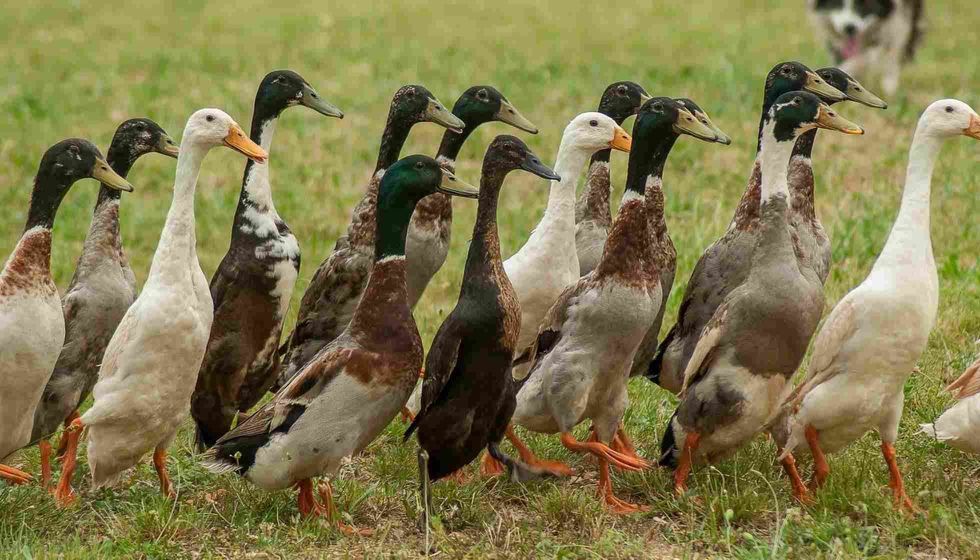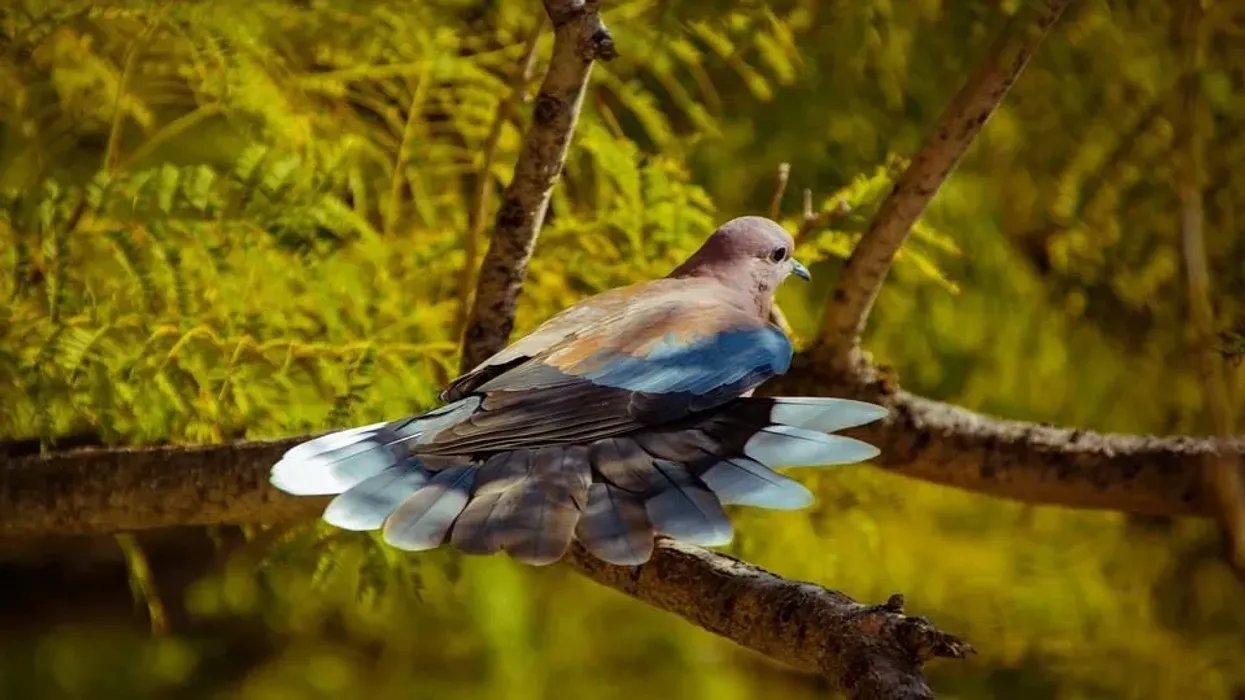The Indian runner duck is one of the most recognizable duck breeds due to its vertical posture, bone definition, striking shape, and variety of colors. This duck, like most domestic duck breeds, has been developed from the wild mallard.
They stand erect like penguins and are also known as penguin ducks. The Indian runner ducks do not waddle like most ducks but can run fast and jump.
These domestic ducks were found on Indonesian Islands and were later imported into Europe.
They can now be found all across the world in a variety of different colors like fawn and white, Cumberland blue, blue trout, dark brown, and black. The Indian runner ducks are especially famous for being prolific egg layers.
They can consistently lay about 300 eggs per year for up to five years. Indian runner ducks are a hardy breed and are not prone to illness, making them a good option for a pet.
Keep reading to know more about this waterfowl. If you enjoy learning about different species, check out the Radjah shelduck and the Muscovy duck.
Indian Runner Duck Interesting Facts
What type of animal is an Indian runner duck?
An Indian runner duck is a type of slender, upright-standing duck.
What class of animal does an Indian runner duck belong to?
The Indian runner duck belongs to the class Aves and the family Anatidae.
How many Indian runner ducks are there in the world?
These birds are domesticated and can be found all over the world, therefore there have not been enough studies to calculate the total population of Indian runners in the world.
Where does an Indian runner duck live?
The Indian runner duck (Anas platyrhynchos domesticus) has its origin in the far East Indies Islands of Lombok, Malaya, Java, and Bali and has been known to be in existence for at least the past 200 years. The runner ducks were found in large numbers in countries like India, Indonesia, and more.
In the 1800s, the species made its way to Europe. This breed was developed from the wild mallard. It has since been domesticated and can be found in many different parts of the world.
What is an Indian runner duck's habitat?
The domesticated Indian runner ducks are one of the most adaptable species and can inhabit diverse climatic regions. The Indian runners need easy access to water like a pond or any artificial water body at all times for drinking and swimming.
They also need a shelter to protect them from extreme weather conditions and a good fence that will keep predators at bay. Indian runners can be found in both saltwater and freshwater wetlands and usually avoid deep waters.
Who do Indian runner ducks live with?
Indian runners form small groups during the breeding seasons and usually live in flocks but can also peacefully co-exist with other domesticated species like chickens. It is a rare phenomenon to see these domesticated ducks living alone.
How long does an Indian runner duck live?
Indian runner ducks have a long lifespan and can live up to 12 years of age when kept domestically. In the wild, they can only survive for approximately five years.
How do they reproduce?
Indian runners are known for their ability to lay a large number of eggs. The female Indian runner ducks are prolific egg layers and can lay approximately 300 to 350 eggs a year.
The eggs are very big and weigh about 2.7 oz (78 g) each on average. The hens can lay a large number of eggs consistently for four to five years.
They have, however, very little maternal instinct and rarely build their nests or sit on their eggs to incubate them. The breeders who raise the ducks use artificial incubators or simply place the eggs under another duck for hatching.
The young ducklings can open their eyes and walk at the time of hatching and are precocial. A duckling can be allowed to go outside after three to five weeks.
What is their conservation status?
Indian runners do not appear in the wild. However, they are found globally in captivity and are Not Listed in the Red List of the International Union for Conservation of Nature or IUCN.
Indian Runner Duck Fun Facts
What do Indian runner ducks look like?

The Indian runner ducks have long, indistinguishable, cylindrical bodies. Their legs are situated at the back of their body, which makes this waterfowl stand upright.
The cylindrical shape and the position of its legs enable it to run quickly and not waddle. They have a lean, wedge-shaped head, compact tail, and a straight bill. This domesticated duck breed has members of various colors.
How cute are they?
Their cylindrical body and long necks with vibrant bills and bright, alert eyes make this duck appear to be very cute.
How do they communicate?
These runners communicate with each other using quacks or the 'hail calls'. This call is mostly used by the mother runners to call their ducklings.
The quack is only used by hens and the drakes use a form of whisper to communicate. Mallards also use different kinds of vocalizations such as coos, whistles, and grunts to communicate with other ducks. The drakes have a very loud call.
How big is an Indian runner duck?
The male and female Indian runners vary in height. The height of a drake is about 30 in (76.2 cm) and the hen is about 20 in (50.8 cm). It is bigger than an average marbled duck.
How fast can an Indian runner duck fly?
Due to its very short wingspan, the Indian runner duck cannot fly. It can, however, walk and run at a much faster speed than other domestic ducks.
How much does an Indian runner duck weigh?
The weight of a drake is approximately 3-5 lb (1.36-2.26 kg) and the weight of a hen is about 2-4 lb (0.9-1.8 kg).
What are the male and female names of the species?
Male Indian runners can be referred to as drakes and the females are known as hens.
What would you call a baby Indian runner duck?
A baby Indian runner duck can be referred to as a duckling.
What do they eat?
The Indian runner duck loves foraging for their food. They feed on mosquitoes, larvae, slugs, snails, small crustaceans, and fish.
Are they dangerous?
The Indian runners are not dangerous or aggressive at all. They are in fact, wonderfully social. They have a timid nature and can panic at seeing any other animal apart from ducks. However, it is very easy to train them and ensure that they are well-behaved at all times.
Would they make a good pet?
Indian runner ducks are good pets if you have a big enough farm or garden. These birds are extremely social, and friendly, and can be trained well.
They can even get extremely attached to their owners.
They need to be provided with at least one artificial body of water where they can swim and live comfortably.
The only thing to keep in mind is that these birds are extremely anxious and feel panicked whenever they see any animal besides a duck, so it is important to be cautious and to keep them in flocks so that they can handle their anxiety in a better way.
Also, be sure to regularly get these waterfowl wormed as worms cause one of the most common health issues for this domestic duck.
Did you know...
Unlike most duck breeds, these domestic ducks do not need water for breeding.
Indian runners are also known as 'bowling pin ducks' as they share the same long and upright thin neck, head, and large body shape as a bowling pin.
The Indian runner duck is not a traditional meat bird, but its meat is considered to be of a quality flavor and similar in taste to wild duck meat.
Some stone carvings in the East Indies, especially Java, point to the fact that this mallard has been in existence for over a thousand years.
Do Indian runner ducks like to swim?
Indian runner ducks love to swim and spend a lot more time doing so than any other domestic duck. When they are allowed free-range, these penguin ducks like to spend most of their time swimming away gracefully.
Can Indian runner ducks live with chickens?
Indian runner ducks, or bowling pin ducks, can peacefully co-exist with chickens. They can sleep together in the same coop.
However, certain precautions need to be taken to ensure that both species can live undisturbed.
The coop should be big enough to fit them both comfortably. Light duck breeds like the runners, prefer to stay on wet surfaces and are messier than chickens, so it becomes crucial that the space for chickens is completely dry and clean at all times, otherwise, this can result in a large number of diseases.
Here at Kidadl, we have carefully created lots of interesting family-friendly animal facts for everyone to discover! Learn more about some other birds including the house finch and the quail.
You can even occupy yourself at home by drawing one of our Indian runner duck coloring pages.










